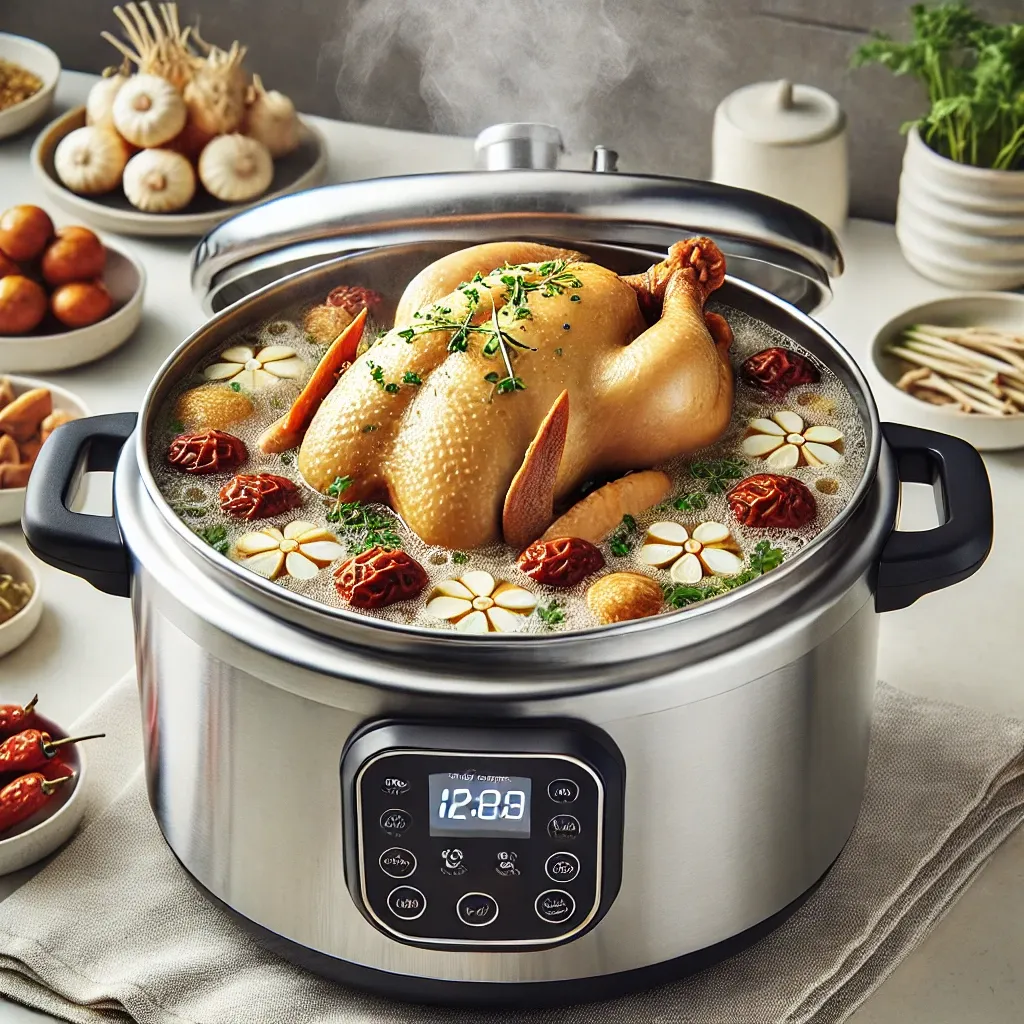What’s the easiest way to get perfect samgyetang at home without babysitting a pot for hours? Curious how long it really takes to make tender, flavor-packed ginseng chicken in a pressure cooker? This post answers all that—and more—so you’ll want to read to the end.
Samgyetang pressure cooker boiling time
Boiling samgyetang in a pressure cooker is a total game-changer. What used to take over an hour now takes just a fraction of the time—with even deeper flavor and fall-off-the-bone chicken.
For most home cooks using a standard 6 to 8-liter pressure cooker, the ideal boiling time for samgyetang is 20 to 25 minutes under full pressure. Here’s a quick breakdown of the entire timeline:
Pressure Cooker Samgyetang Boiling Timeline:
-
Prep Time: 10–15 minutes (cleaning chicken, stuffing rice, slicing herbs)
-
Pre-heat & Pressure Buildup: 10 minutes
-
Pressure Cooking: 20–25 minutes
-
Natural Pressure Release: 10–15 minutes
-
Final Adjustments (seasoning/toppings): 5 minutes
With this method, your chicken will be tender but intact, the glutinous rice stuffing fully cooked, and the broth richly infused with ginseng, jujubes, and garlic. What’s even better? The entire process stays mess-free and low-effort.
Let’s break down how this cooking time impacts each part of the dish:
-
Chicken texture: Becomes melt-in-the-mouth without falling apart.
-
Glutinous rice: Cooks evenly inside the cavity, absorbing all the flavor.
-
Herbs and broth: Fully meld and develop their depth in the enclosed environment.
💡 Pro Tip: For stronger herbal flavor, you can soak your ginseng and jujubes in warm water for 20 minutes before adding them to the cooker.
Two personal test cases really proved this timing sweet spot:
-
Case 1: I tried 15 minutes at full pressure—chicken was slightly undercooked near the thigh joint.
-
Case 2: At 30 minutes, the chicken started falling apart when serving—still tasty but less photogenic.
So stick to that 20–25 minute zone for restaurant-quality results at home.
👉”Check More Samgyetang Timing Tips”👈
How to boil samgyetang
Boiling samgyetang is a beautiful ritual in Korean cuisine—a nourishing blend of ancient tradition and comfort food simplicity. It starts with just a few humble ingredients and transforms them into something unforgettable.
Here’s how to boil samgyetang from scratch, step-by-step, whether you’re using a regular pot or planning to transfer to a pressure cooker later:
Basic Ingredients You’ll Need:
-
1 small whole chicken (about 600–800g)
-
½ cup glutinous rice (soaked for 1 hour)
-
4–6 garlic cloves
-
2 dried jujubes
-
1 small ginseng root (or substitute with ginseng powder)
-
2–3 chestnuts (optional)
-
Water (enough to submerge chicken)
-
Salt and pepper to taste
-
Green onions for garnish
Traditional Boiling Method:
-
Clean the chicken thoroughly and remove internal organs if necessary.
-
Stuff the cavity with soaked glutinous rice, garlic, ginseng, and jujubes.
-
Use toothpicks or cooking twine to close the opening.
-
Place in a large pot and fill with water until fully submerged.
-
Bring to a boil, then reduce heat to medium and simmer for 1.5 to 2 hours.
-
Skim off any foam or fat during cooking.
-
Season with salt and pepper, garnish, and serve hot.
This method brings out a gentle, subtle broth with a deep medicinal warmth. When I first made it this way for my in-laws, they said it was “like something their mother used to make.” That hit home.
And if you ever wondered, “Why does samgyetang feel so restorative?”—it’s not just the herbs. It’s the low and slow boil that creates a silky mouthfeel and soul-soothing depth.
That said, the long cooking time can be a bit much on busy days. This is where modern methods like pressure cookers or even rice cookers come in handy.
👉”Full Samgyetang Recipe Guide”👈
How to boil Samgyetang pressure cooker
Now let’s walk through exactly how to boil samgyetang in a pressure cooker, with full instructions that bring out all the deep, nourishing flavors while saving you serious time and cleanup.
Step-by-Step Pressure Cooker Samgyetang:
-
Soak glutinous rice for 30 minutes to 1 hour in warm water.
-
Prepare the chicken: Clean inside and out, remove giblets if included.
-
Stuff the chicken with the soaked rice, 2 garlic cloves, a jujube, and ginseng root.
-
Secure the cavity with a toothpick or small skewer.
-
Place chicken inside the pressure cooker and pour in 4–6 cups of water.
-
Add remaining garlic, jujubes, chestnuts, and herbs around the chicken.
-
Lock the lid and set to high pressure for 20–25 minutes.
-
Let it naturally release for about 10–15 minutes before opening.
-
Season to taste with salt and pepper after opening.
-
Garnish with sliced green onions and sesame seeds if desired.
One thing I love about this method is that it retains all the nutrition—the sealed pressure environment prevents ginseng aroma and nutrients from evaporating. You get more flavor, more nourishment, and a deeply satisfying broth.
I remember the first time I cooked it this way. It was in the middle of winter. I came back from a cold walk, opened the lid—and that rich aroma hit me like a warm hug. The rice inside was perfectly sticky, the garlic had melted into the broth, and the meat? Like butter.
Another variation I’ve tested is adding a spoonful of Korean medicinal herb mix (한방재료), available in most Asian groceries. It gives the soup an even deeper, slightly earthy profile—great for flu season or post-travel fatigue.
For people with smaller cookers or less time, don’t overpack. One small chicken per cooking session is ideal for even results.
👉”Learn More Samgyetang Cooking Methods”👈
Conclusion
Boiling samgyetang—especially with a pressure cooker—turns a time-consuming tradition into an accessible, soul-warming meal for any night of the week. Whether you’re craving rich comfort food, boosting your health, or just trying to reconnect with Korean flavors, this dish delivers every time.
As Anthony Bourdain once said, “You learn a lot about someone when you share a meal together.” And samgyetang is one of those meals that tells a whole story in one bowl—from ancient medicine to modern mastery.
Take these techniques, try them at home, and let the aroma of ginseng and garlic fill your kitchen.






